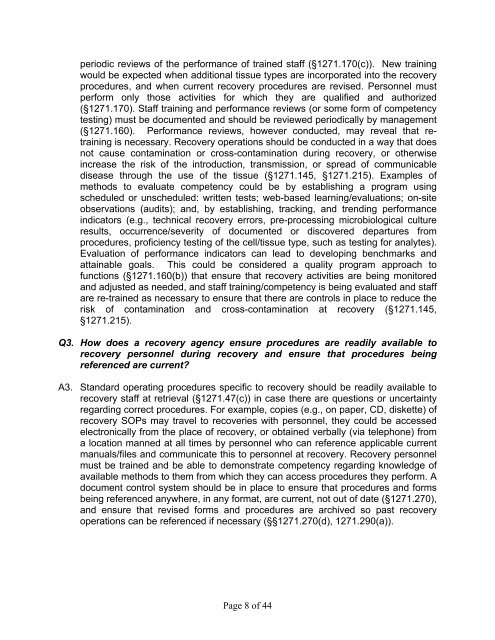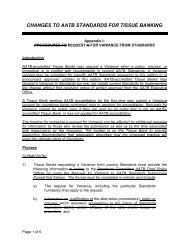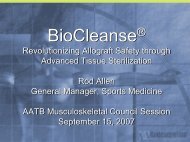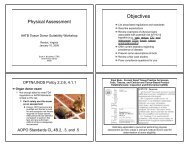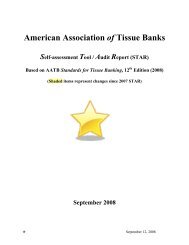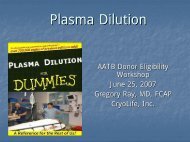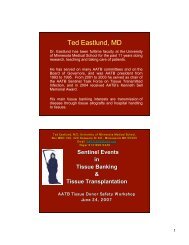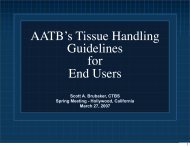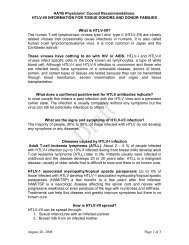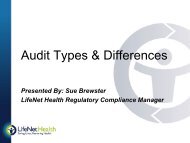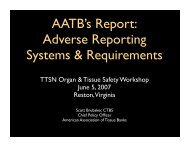Guidance Document - American Association of Tissue Banks
Guidance Document - American Association of Tissue Banks
Guidance Document - American Association of Tissue Banks
- No tags were found...
You also want an ePaper? Increase the reach of your titles
YUMPU automatically turns print PDFs into web optimized ePapers that Google loves.
periodic reviews <strong>of</strong> the performance <strong>of</strong> trained staff (§1271.170(c)). New trainingwould be expected when additional tissue types are incorporated into the recoveryprocedures, and when current recovery procedures are revised. Personnel mustperform only those activities for which they are qualified and authorized(§1271.170). Staff training and performance reviews (or some form <strong>of</strong> competencytesting) must be documented and should be reviewed periodically by management(§1271.160). Performance reviews, however conducted, may reveal that retrainingis necessary. Recovery operations should be conducted in a way that doesnot cause contamination or cross-contamination during recovery, or otherwiseincrease the risk <strong>of</strong> the introduction, transmission, or spread <strong>of</strong> communicabledisease through the use <strong>of</strong> the tissue (§1271.145, §1271.215). Examples <strong>of</strong>methods to evaluate competency could be by establishing a program usingscheduled or unscheduled: written tests; web-based learning/evaluations; on-siteobservations (audits); and, by establishing, tracking, and trending performanceindicators (e.g., technical recovery errors, pre-processing microbiological cultureresults, occurrence/severity <strong>of</strong> documented or discovered departures fromprocedures, pr<strong>of</strong>iciency testing <strong>of</strong> the cell/tissue type, such as testing for analytes).Evaluation <strong>of</strong> performance indicators can lead to developing benchmarks andattainable goals. This could be considered a quality program approach t<strong>of</strong>unctions (§1271.160(b)) that ensure that recovery activities are being monitoredand adjusted as needed, and staff training/competency is being evaluated and staffare re-trained as necessary to ensure that there are controls in place to reduce therisk <strong>of</strong> contamination and cross-contamination at recovery (§1271.145,§1271.215).Q3. How does a recovery agency ensure procedures are readily available torecovery personnel during recovery and ensure that procedures beingreferenced are current?A3. Standard operating procedures specific to recovery should be readily available torecovery staff at retrieval (§1271.47(c)) in case there are questions or uncertaintyregarding correct procedures. For example, copies (e.g., on paper, CD, diskette) <strong>of</strong>recovery SOPs may travel to recoveries with personnel, they could be accessedelectronically from the place <strong>of</strong> recovery, or obtained verbally (via telephone) froma location manned at all times by personnel who can reference applicable currentmanuals/files and communicate this to personnel at recovery. Recovery personnelmust be trained and be able to demonstrate competency regarding knowledge <strong>of</strong>available methods to them from which they can access procedures they perform. Adocument control system should be in place to ensure that procedures and formsbeing referenced anywhere, in any format, are current, not out <strong>of</strong> date (§1271.270),and ensure that revised forms and procedures are archived so past recoveryoperations can be referenced if necessary (§§1271.270(d), 1271.290(a)).Page 8 <strong>of</strong> 44


